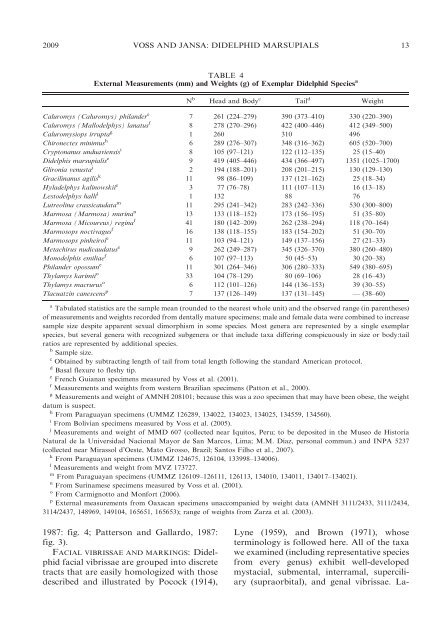phylogenetic relationships and classification of didelphid marsupials ...
phylogenetic relationships and classification of didelphid marsupials ...
phylogenetic relationships and classification of didelphid marsupials ...
You also want an ePaper? Increase the reach of your titles
YUMPU automatically turns print PDFs into web optimized ePapers that Google loves.
2009 VOSS AND JANSA: DIDELPHID MARSUPIALS 13<br />
TABLE 4<br />
External Measurements (mm) <strong>and</strong> Weights (g) <strong>of</strong> Exemplar Didelphid Species a<br />
Caluromys (Caluromys) phil<strong>and</strong>er e<br />
Caluromys (Mallodelphys) lanatus f<br />
Caluromysiops irrupta g<br />
Chironectes minimus h<br />
Cryptonanus unduaviensis i<br />
Didelphis marsupialis e<br />
Glironia venusta j<br />
Gracilinanus agilis k<br />
Hyladelphys kalinowskii e<br />
Lestodelphys halli l<br />
Lutreolina crassicaudata m<br />
Marmosa (Marmosa) murina n<br />
Marmosa (Micoureus) regina f<br />
Marmosops noctivagus f<br />
Marmosops pinheiroi e<br />
Metachirus nudicaudatus e<br />
Monodelphis emiliae f<br />
Phil<strong>and</strong>er opossum e<br />
Thylamys karimii o<br />
Thylamys macrurus o<br />
Tlacuatzin canescens p<br />
1987: fig. 4; Patterson <strong>and</strong> Gallardo, 1987:<br />
fig. 3).<br />
FACIAL VIBRISSAE AND MARKINGS: Didelphid<br />
facial vibrissae are grouped into discrete<br />
tracts that are easily homologized with those<br />
described <strong>and</strong> illustrated by Pocock (1914),<br />
N b<br />
Head <strong>and</strong> Body c<br />
Tail d<br />
Weight<br />
7 261 (224–279) 390 (373–410) 330 (220–390)<br />
8 278 (270–296) 422 (400–446) 412 (349–500)<br />
1 260 310 496<br />
6 289 (276–307) 348 (316–362) 605 (520–700)<br />
8 105 (97–121) 122 (112–135) 25 (15–40)<br />
9 419 (405–446) 434 (366–497) 1351 (1025–1700)<br />
2 194 (188–201) 208 (201–215) 130 (129–130)<br />
11 98 (86–109) 137 (121–162) 25 (18–34)<br />
3 77 (76–78) 111 (107–113) 16 (13–18)<br />
1 132 88 76<br />
11 295 (241–342) 283 (242–336) 530 (300–800)<br />
13 133 (118–152) 173 (156–195) 51 (35–80)<br />
41 180 (142–209) 262 (238–294) 118 (70–164)<br />
16 138 (118–155) 183 (154–202) 51 (30–70)<br />
11 103 (94–121) 149 (137–156) 27 (21–33)<br />
9 262 (249–287) 345 (326–370) 380 (260–480)<br />
6 107 (97–113) 50 (45–53) 30 (20–38)<br />
11 301 (264–346) 306 (280–333) 549 (380–695)<br />
33 104 (78–129) 80 (69–106) 28 (16–43)<br />
6 112 (101–126) 144 (136–153) 39 (30–55)<br />
7 137 (126–149) 137 (131–145) — (38–60)<br />
a<br />
Tabulated statistics are the sample mean (rounded to the nearest whole unit) <strong>and</strong> the observed range (in parentheses)<br />
<strong>of</strong> measurements <strong>and</strong> weights recorded from dentally mature specimens; male <strong>and</strong> female data were combined to increase<br />
sample size despite apparent sexual dimorphism in some species. Most genera are represented by a single exemplar<br />
species, but several genera with recognized subgenera or that include taxa differing conspicuously in size or body:tail<br />
ratios are represented by additional species.<br />
b<br />
Sample size.<br />
c<br />
Obtained by subtracting length <strong>of</strong> tail from total length following the st<strong>and</strong>ard American protocol.<br />
d<br />
Basal flexure to fleshy tip.<br />
e<br />
French Guianan specimens measured by Voss et al. (2001).<br />
f<br />
Measurements <strong>and</strong> weights from western Brazilian specimens (Patton et al., 2000).<br />
g<br />
Measurements <strong>and</strong> weight <strong>of</strong> AMNH 208101; because this was a zoo specimen that may have been obese, the weight<br />
datum is suspect.<br />
h<br />
From Paraguayan specimens (UMMZ 126289, 134022, 134023, 134025, 134559, 134560).<br />
i<br />
From Bolivian specimens measured by Voss et al. (2005).<br />
j<br />
Measurements <strong>and</strong> weight <strong>of</strong> MMD 607 (collected near Iquitos, Peru; to be deposited in the Museo de Historia<br />
Natural de la Universidad Nacional Mayor de San Marcos, Lima; M.M. Díaz, personal commun.) <strong>and</strong> INPA 5237<br />
(collected near Mirassol d’Oeste, Mato Grosso, Brazil; Santos Filho et al., 2007).<br />
k<br />
From Paraguayan specimens (UMMZ 124675, 126104, 133998–134006).<br />
l<br />
Measurements <strong>and</strong> weight from MVZ 173727.<br />
m<br />
From Paraguayan specimens (UMMZ 126109–126111, 126113, 134010, 134011, 134017–134021).<br />
n<br />
From Surinamese specimens measured by Voss et al. (2001).<br />
o<br />
From Carmignotto <strong>and</strong> Monfort (2006).<br />
p<br />
External measurements from Oaxacan specimens unaccompanied by weight data (AMNH 3111/2433, 3111/2434,<br />
3114/2437, 148969, 149104, 165651, 165653); range <strong>of</strong> weights from Zarza et al. (2003).<br />
Lyne (1959), <strong>and</strong> Brown (1971), whose<br />
terminology is followed here. All <strong>of</strong> the taxa<br />
we examined (including representative species<br />
from every genus) exhibit well-developed<br />
mystacial, submental, interramal, superciliary<br />
(supraorbital), <strong>and</strong> genal vibrissae. La-

















